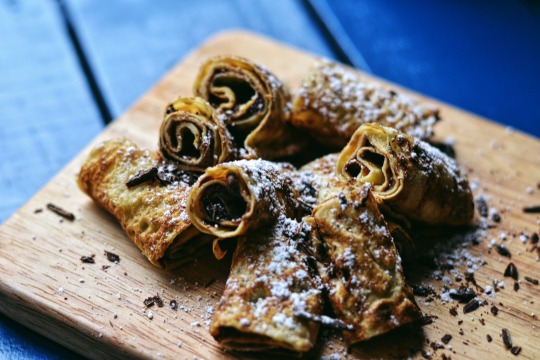


Photograph(s) © David Katzenstein
A few days ago I was talking on the phone with my aunt. We talk about once a week and sometimes our talks last over an hour. In our last conversation we were talking about writing, and she told me that the most important thing to remember is “write what you know.”
I began thinking, “what do I know?!” I know cookies. I know pies. I know Southern comfort food. I also know crêpes, and I think everyone else should know about crêpes too.
When I was living in New York, I actually got three separate gigs serving crêpes at events. It was funny to imagine being a Crêpier, but I’m always up for a challenge or a new experience, so I went for it! Two of the events were for Festival Daniou (www.festivaldaniou.com). Festival Daniou is a Brittany-based summer chamber music residency for internationally recognized young musicians that engages with the history, culture, and cuisine of its region through performance. The first three photos on this post are from the first time I made crêpes at the festival! And before you ask – yes, that’s my majestic pouring and wrist swirling in action. 😉
Both events were lovely and I had the opportunity to serve miniature Kouign-amann, profiteroles and classic galettes. Brittany is well known as the place where Kouign-amann and crêpes themselves began. Crêpes were then known as galettes, which means “flat cake.” They were made with buckwheat flour, which gave the crêpe a much heartier, earthy flavor.
I don’t know how many crêpes I’ve made, but I’d guess it’s close to 1,000. When I began making crêpes in my apartment in Brooklyn, I tested several different recipes that the Festival Danilou organizer Simon Frisch had passed down to me from his family! A lot of them were still in French, and they were all handwritten. I tested, failed, burned, flipped, ate, and shared a lot of crêpes with my roommates. It took me at least a week to master the perfect flick of the wrist that would flip the crêpe over mid-air. I still mess it up to this day though! Around that same time my husband bought me my own crêpe pan as an anniversary gift, and the rest is history.
The recipe I’m posting is for regular crêpes with all purpose flour. Perhaps in the future I’ll do a post on galettes, but for now this is a good place to start. The aforementioned anniversary crêpe pan is still in the US (because it’s heavy!), but using a normal frying pan or cast iron is totally fine.

I like my crêpes a little thinner and delicate than most, I’d say. If you want a more cake-like, thick crêpe, omit the ¼ cup of water. Or just make pancakes. You could also use only water instead of milk. Once you master the basic crêpe, you can change everything around to find your perfect recipe.
Ingredients for 12-14 crêpes*:
*depends on pan size, egg size, etc.
1 cup whole milk
¼ cup water
4 eggs, beaten
½ cup flour
½ teaspoon salt
Butter, for frying pan
1 tablespoon sugar (if making sweet crepes)
1. Sift flour and salt together.
2. Combine beaten eggs and milk.
3. Using a fork or whisk to mix, slowly pour the milk and egg mixture into the center of the bowl of flour. Mix it together gradually, and slowly add more liquid as you go. This will avoid clumps. The total mixing should take about 2 minutes – don’t rush it!
(Alternatively, you can combine all the ingredients in a blender and pulse for 30 seconds until combined and bubbly – but why get the blender dirty when you can mix it by hand?)
4. You now must let the batter rest for at least one hour at room temperature. Trust me (or overnight), you don’t want a gummy crêpe.
5. Heat your frying pan over medium-high. When you drop a pat of butter in the pan, it should hiss and fuss. If it doesn’t your pan isn’t hot enough. You want to maintain this temperature the entire time you’re cooking the crêpes. You also want to keep adding butter, or your crêpe will get stuck. The butter also promotes gorgeous browning. I used nearly a stick of butter making 12 crêpes. I really love butter.
6. Pour about ¼ cup of batter into the pan, swirling with your wrist to evenly cover the pan’s surface. Depending on pan size, you may need more or you may need less. If it doesn’t cover the whole pan, pour in a little more in the vacant spaces.
7. The crêpe will cook on each side for 1-2 minutes, until golden brown. Loosen the edges of the crêpe with a (heatproof!) spatula, then flip it. Some people use their fingers. Some people use an offset spatula. Some people, like me, try to flip it with a flick of the wrist. Cook all the crêpes and leave them in a beautiful stack under some tin foil if you are serving them soon. If not, they’re just as good reheated in the oven.

Before the flip…

And after. Now all that’s left to do is serve your crêpes however you please!
You could add ham and cheese, and melt it together in the oven…

You could add melted chocolate, or Nutella, if you must.

You could smear some greek yogurt, berries and honey on them.

No matter how you serve them, they’re delicious and versatile!
Like my new Facebook page for more recipes and updates at http://www.facebook.com/thealexanderroberts
